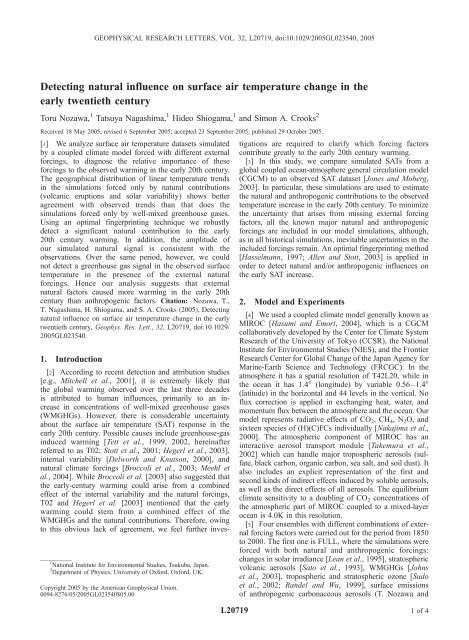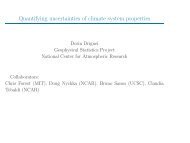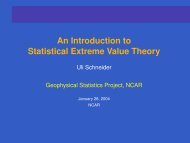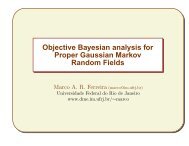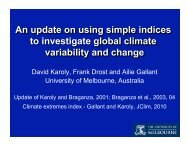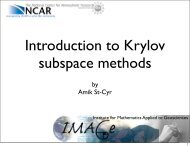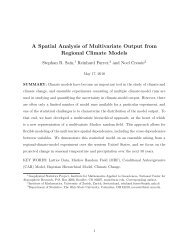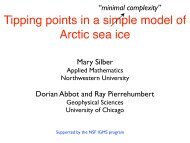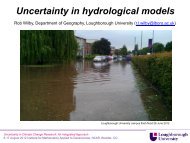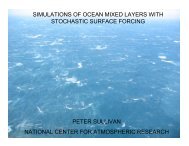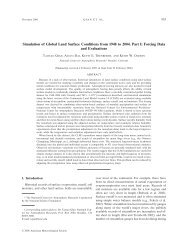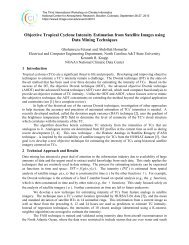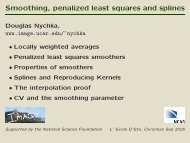Detecting natural influence on surface air temperature ... - IMAGe
Detecting natural influence on surface air temperature ... - IMAGe
Detecting natural influence on surface air temperature ... - IMAGe
Create successful ePaper yourself
Turn your PDF publications into a flip-book with our unique Google optimized e-Paper software.
GEOPHYSICAL RESEARCH LETTERS, VOL. 32, L20719, doi:10.1029/2005GL023540, 2005<str<strong>on</strong>g>Detecting</str<strong>on</strong>g> <str<strong>on</strong>g>natural</str<strong>on</strong>g> <str<strong>on</strong>g>influence</str<strong>on</strong>g> <strong>on</strong> <strong>surface</strong> <strong>air</strong> <strong>temperature</strong> change in theearly twentieth centuryToru Nozawa, 1 Tatsuya Nagashima, 1 Hideo Shiogama, 1 and Sim<strong>on</strong> A. Crooks 2Received 18 May 2005; revised 6 September 2005; accepted 23 September 2005; published 29 October 2005.[1] We analyze <strong>surface</strong> <strong>air</strong> <strong>temperature</strong> datasets simulatedby a coupled climate model forced with different externalforcings, to diagnose the relative importance of theseforcings to the observed warming in the early 20th century.The geographical distributi<strong>on</strong> of linear <strong>temperature</strong> trendsin the simulati<strong>on</strong>s forced <strong>on</strong>ly by <str<strong>on</strong>g>natural</str<strong>on</strong>g> c<strong>on</strong>tributi<strong>on</strong>s(volcanic erupti<strong>on</strong>s and solar variability) shows betteragreement with observed trends than that does thesimulati<strong>on</strong>s forced <strong>on</strong>ly by well-mixed greenhouse gases.Using an optimal fingerprinting technique we robustlydetect a significant <str<strong>on</strong>g>natural</str<strong>on</strong>g> c<strong>on</strong>tributi<strong>on</strong> to the early20th century warming. In additi<strong>on</strong>, the amplitude ofour simulated <str<strong>on</strong>g>natural</str<strong>on</strong>g> signal is c<strong>on</strong>sistent with theobservati<strong>on</strong>s. Over the same period, however, we couldnot detect a greenhouse gas signal in the observed <strong>surface</strong><strong>temperature</strong> in the presence of the external <str<strong>on</strong>g>natural</str<strong>on</strong>g>forcings. Hence our analysis suggests that external<str<strong>on</strong>g>natural</str<strong>on</strong>g> factors caused more warming in the early 20thcentury than anthropogenic factors. Citati<strong>on</strong>: Nozawa, T.,T. Nagashima, H. Shiogama, and S. A. Crooks (2005), <str<strong>on</strong>g>Detecting</str<strong>on</strong>g><str<strong>on</strong>g>natural</str<strong>on</strong>g> <str<strong>on</strong>g>influence</str<strong>on</strong>g> <strong>on</strong> <strong>surface</strong> <strong>air</strong> <strong>temperature</strong> change in the earlytwentieth century, Geophys. Res. Lett., 32, L20719, doi:10.1029/2005GL023540.1 Nati<strong>on</strong>al Institute for Envir<strong>on</strong>mental Studies, Tsukuba, Japan.2 Department of Physics, University of Oxford, Oxford, UK.Copyright 2005 by the American Geophysical Uni<strong>on</strong>.0094-8276/05/2005GL023540$05.001. Introducti<strong>on</strong>[2] According to recent detecti<strong>on</strong> and attributi<strong>on</strong> studies[e.g., Mitchell et al., 2001], it is extremely likely thatthe global warming observed over the last three decadesis attributed to human <str<strong>on</strong>g>influence</str<strong>on</strong>g>s, primarily to an increasein c<strong>on</strong>centrati<strong>on</strong>s of well-mixed greenhouse gases(WMGHGs). However, there is c<strong>on</strong>siderable uncertaintyabout the <strong>surface</strong> <strong>air</strong> <strong>temperature</strong> (SAT) resp<strong>on</strong>se in theearly 20th century. Possible causes include greenhouse-gasinduced warming [Tett et al., 1999, 2002, hereinafterreferred to as T02; Stott et al., 2001; Hegerl et al., 2003],internal variability [Delworth and Knuts<strong>on</strong>, 2000], and<str<strong>on</strong>g>natural</str<strong>on</strong>g> climate forcings [Broccoli et al., 2003; Meehl etal., 2004]. While Broccoli et al. [2003] also suggested thatthe early-century warming could arise from a combinedeffect of the internal variability and the <str<strong>on</strong>g>natural</str<strong>on</strong>g> forcings,T02 and Hegerl et al. [2003] menti<strong>on</strong>ed that the earlywarming could stem from a combined effect of theWMGHGs and the <str<strong>on</strong>g>natural</str<strong>on</strong>g> c<strong>on</strong>tributi<strong>on</strong>s. Therefore, owingto this obvious lack of agreement, we feel further investigati<strong>on</strong>sare required to clarify which forcing factorsc<strong>on</strong>tribute greatly to the early 20th century warming.[3] In this study, we compare simulated SATs from aglobal coupled ocean-atmosphere general circulati<strong>on</strong> model(CGCM) to an observed SAT dataset [J<strong>on</strong>es and Moberg,2003]. In particular, these simulati<strong>on</strong>s are used to estimatethe <str<strong>on</strong>g>natural</str<strong>on</strong>g> and anthropogenic c<strong>on</strong>tributi<strong>on</strong>s to the observed<strong>temperature</strong> increase in the early 20th century. To minimizethe uncertainty that arises from missing external forcingfactors, all the known major <str<strong>on</strong>g>natural</str<strong>on</strong>g> and anthropogenicforcings are included in our model simulati<strong>on</strong>s, although,as in all historical simulati<strong>on</strong>s, inevitable uncertainties in theincluded forcings remain. An optimal fingerprinting method[Hasselmann, 1997; Allen and Stott, 2003] is applied inorder to detect <str<strong>on</strong>g>natural</str<strong>on</strong>g> and/or anthropogenic <str<strong>on</strong>g>influence</str<strong>on</strong>g>s <strong>on</strong>the early SAT increase.2. Model and Experiments[4] We used a coupled climate model generally known asMIROC [Hasumi and Emori, 2004], which is a CGCMcollaboratively developed by the Center for Climate SystemResearch of the University of Tokyo (CCSR), the Nati<strong>on</strong>alInstitute for Envir<strong>on</strong>mental Studies (NIES), and the Fr<strong>on</strong>tierResearch Center for Global Change of the Japan Agency forMarine-Earth Science and Technology (FRCGC). In theatmosphere it has a spatial resoluti<strong>on</strong> of T42L20, while inthe ocean it has 1.4° (l<strong>on</strong>gitude) by variable 0.56–1.4°(latitude) in the horiz<strong>on</strong>tal and 44 levels in the vertical. Noflux correcti<strong>on</strong> is applied in exchanging heat, water, andmomentum flux between the atmosphere and the ocean. Ourmodel represents radiative effects of CO 2 ,CH 4 ,N 2 O, andsixteen species of (H)(C)FCs individually [Nakajima et al.,2000]. The atmospheric comp<strong>on</strong>ent of MIROC has aninteractive aerosol transport module [Takemura et al.,2002] which can handle major tropospheric aerosols (sulfate,black carb<strong>on</strong>, organic carb<strong>on</strong>, sea salt, and soil dust). Italso includes an explicit representati<strong>on</strong> of the first andsec<strong>on</strong>d kinds of indirect effects induced by soluble aerosols,as well as the direct effects of all aerosols. The equilibriumclimate sensitivity to a doubling of CO 2 c<strong>on</strong>centrati<strong>on</strong>s ofthe atmospheric part of MIROC coupled to a mixed-layerocean is 4.0K in this resoluti<strong>on</strong>.[5] Four ensembles with different combinati<strong>on</strong>s of externalforcing factors were carried out for the period from 1850to 2000. The first <strong>on</strong>e is FULL, where the simulati<strong>on</strong>s wereforced with both <str<strong>on</strong>g>natural</str<strong>on</strong>g> and anthropogenic forcings:changes in solar irradiance [Lean et al., 1995], stratosphericvolcanic aerosols [Sato et al., 1993], WMGHGs [Johnset al., 2003], tropospheric and stratospheric oz<strong>on</strong>e [Sudoet al., 2002; Randel and Wu, 1999], <strong>surface</strong> emissi<strong>on</strong>sof anthropogenic carb<strong>on</strong>aceous aerosols (T. Nozawa andL207191of4
L20719 NOZAWA ET AL.: NATURAL INFLUENCE ON EARLY WARMING L20719the <str<strong>on</strong>g>natural</str<strong>on</strong>g> and the anthropogenic forcings, respectively. Thefinal ensemble is GHG, where the simulati<strong>on</strong>s were forcedwith changes in WMGHGs <strong>on</strong>ly. Each ensemble c<strong>on</strong>sists offour ensemble simulati<strong>on</strong>s starting from different initialc<strong>on</strong>diti<strong>on</strong>s taken from a pre-industrial c<strong>on</strong>trol run.[6] The pre-industrial c<strong>on</strong>trol run is performed for1300 years after a 200-year spin up simulati<strong>on</strong>. The c<strong>on</strong>trolrun shows no significant climate drift; linear trend in theglobal annual mean SAT is no more than 0.02K/century. Inadditi<strong>on</strong>, simulated decadal variability of the c<strong>on</strong>trol run iscomparable to the decadal variability found in observati<strong>on</strong>s.For example, the standard deviati<strong>on</strong> of the observed globaldecadal mean SAT, calculated from linearly detrended datafor the 1900–1949 period, falls within the minimumand maximum range of the simulated standard deviati<strong>on</strong>sfor 50-year segments of the c<strong>on</strong>trol run. An F-test revealsthat there is no significant disagreement between the observedand the modeled decadal variability.Figure 1. Temporal variati<strong>on</strong>s of global annual mean<strong>surface</strong> <strong>air</strong> <strong>temperature</strong> (SAT). Anomalies from the 1881–1910 mean for the observati<strong>on</strong>s [J<strong>on</strong>es and Moberg, 2003](thick black line) and the ensemble mean of the FULL,NTRL, ANTH, and GHG simulati<strong>on</strong>s (thick red lines).Maximum and minimum ranges from the individualsimulati<strong>on</strong>s are shaded in light red. In calculating the globalannual mean SAT, modeled data are projected <strong>on</strong>to the sameresoluti<strong>on</strong> of the observati<strong>on</strong>s discarding simulated data atgrid points where there was missing observati<strong>on</strong>al data.More than ten m<strong>on</strong>ths of data were required at each locati<strong>on</strong>to calculate the annual mean value.J. Kurokawa, Historical and future emissi<strong>on</strong>s of sulfurdioxide and black carb<strong>on</strong> for global and regi<strong>on</strong>al climatechange studies, manuscript in preparati<strong>on</strong>, 2005) and precursorsof sulfate aerosols [Lefohn et al., 1999] and land-use[Hirabayashi et al., 2005]. The sec<strong>on</strong>d is NTRL and thethird is ANTH, where the simulati<strong>on</strong>s were forced with3. Results[7] Figure 1 shows temporal variati<strong>on</strong>s of the globalannual mean SAT for the FULL, NTRL, ANTH, andGHG ensembles. The observed SAT is superposed <strong>on</strong> eachensemble. The FULL ensemble captures well the observedmulti-decadal variati<strong>on</strong>s throughout the 20th century. In allensembles except for NTRL, simulated SATs show remarkable<strong>temperature</strong> increase after 1970s in close agreementwith observed <strong>temperature</strong>s, suggesting that the observedwarming in the recent three decades resulted primarily froman increase in c<strong>on</strong>centrati<strong>on</strong>s of WMGHGs. On the otherhand, all ensembles other than ANTH capture the earlycenturywarming. In the ANTH simulati<strong>on</strong>s, the warmingdue to WMGHGs is offset by a cooling due to increases inanthropogenic aerosols, resulting in no significant warminguntil 1950s (T. Nagashima et al., Effect of carb<strong>on</strong>aceousaerosols <strong>on</strong> the <strong>surface</strong> <strong>temperature</strong> in the mid 20th century,submitted to Geophysical Research Letters, 2005). Thesimulated <strong>temperature</strong> increase in NTRL in the first halfof the 20th century is about 0.5K/century, which is slightlyless than that in the observati<strong>on</strong>s. This global annual meanFigure 2. Geographical distributi<strong>on</strong>s of linear SAT trends (K/decade) in the first half of the century for the (a) observati<strong>on</strong>s[J<strong>on</strong>es and Moberg, 2003] and the ensemble means of the (b) FULL, (c) NTRL, (d) ANTH, and (e) GHG simulati<strong>on</strong>s.Trends were calculated from annual mean values <strong>on</strong>ly for those grids where the annual data is available in at least 2/3 of the50 years and distributed in time without significant bias.2of4
L20719 NOZAWA ET AL.: NATURAL INFLUENCE ON EARLY WARMING L20719Figure 3. Best-estimated (a, b) signal amplitudes and (c, d)linear trends (K/century) with 5–95% uncertainty ranges forthe 50-year segment from 1900 to 1949 for the GHG,ANTH-GHG (anthropogenic signal other than WMGHGs)(Figures 3a and 3c), and the NTRL analysis and for theANTH and NTRL analysis (Figures 3b and 3d). The orangeerror bar with an asterisk, green error bar with a diam<strong>on</strong>d,light green error bar with a cross, and blue error bar with atriangle indicates GHG, ANTH-GHG, ANTH, and NTRL,respectively. Also shown in Figures 3c and 3d are the totalrec<strong>on</strong>structed trend from the regressi<strong>on</strong> model (red error barwith a plus) and the observed (solid error bar with a square)trend. Error bars denote 5–95% uncertainty ranges.SAT trend in NTRL is larger than that of Stott et al. [2000]and T02 (0.3K/century) for their simulati<strong>on</strong>s with <str<strong>on</strong>g>natural</str<strong>on</strong>g>forcings <strong>on</strong>ly, although we use identical <str<strong>on</strong>g>natural</str<strong>on</strong>g> forcingdatasets to the <strong>on</strong>es they used. The trend of the globalannual mean SAT in GHG is nearly equal to that in NTRL;therefore, without further investigati<strong>on</strong>, we cannot c<strong>on</strong>cludewhich factors are the main c<strong>on</strong>tributors to the observedearly warming.[8] Geographical distributi<strong>on</strong>s of linear SAT trends forthe first half of the century are shown in Figure 2 for theobservati<strong>on</strong>s and the ensemble mean of each ensemble. Thetrend patterns in NTRL as well as in FULL (Figures 2band 2c) compare quite favorably with the trend patterndrawn from the observati<strong>on</strong>s (Figure 2a). In the ANTHsimulati<strong>on</strong>s, <strong>on</strong> the other hand, the indirect effect ofanthropogenic aerosols introduces cooling trends in theNorth America and the Northern Atlantic (Figure 2d),where the observed warming was largest in this period(1900–1949) (Figure 2a). The trend pattern in GHG(Figure 2e) looks less similar to the trends in the observati<strong>on</strong>sthan do the trends in NTRL.[9] To clarify the relative importance of the effect ofWMGHGs and <str<strong>on</strong>g>natural</str<strong>on</strong>g> <str<strong>on</strong>g>influence</str<strong>on</strong>g>s <strong>on</strong> the warming in theearly 20th century, an optimal detecti<strong>on</strong> method usingtotal least squares regressi<strong>on</strong> (TLS) [Allen and Stott,2003] was applied to the simulated and observed SAT.In c<strong>on</strong>trast to ordinary least squares regressi<strong>on</strong> (OLS), aswas used in many previous studies (e.g., T02), TLS takesinto account sampling uncertainty in the model resp<strong>on</strong>seswhen estimating the signal amplitudes, and gives anunbiased regressi<strong>on</strong> coefficient. Similar to the analysisof T02, we regress the observed spatio-temporal variati<strong>on</strong>s<strong>on</strong>to the three model-derived resp<strong>on</strong>se patterns fromGHG, ANTH, and NTRL to estimate the signal amplitudesfor GHG, ANTH-GHG (i.e., the <strong>temperature</strong> resp<strong>on</strong>seto all the anthropogenic <str<strong>on</strong>g>influence</str<strong>on</strong>g>s exceptWMGHGs) and NTRL effects. The signal amplitude forANTH-GHG is computed via a linear transformati<strong>on</strong> fromthe GHG and ANTH resp<strong>on</strong>ses (see T02 for moredetails). Following the approach of Stott et al. [2001]the observed and simulated SATs in the early 20thcentury (1900–1949) were averaged decadally, expressedas anomalies with respect to the same period, and filteredby projecting <strong>on</strong>to T4 spherical harm<strong>on</strong>ics. We calculatethe signal amplitudes by estimating covariance matrices,for optimizati<strong>on</strong>, from intra-ensemble spread of theensembles using a truncati<strong>on</strong> of 10 EOFs. Applying theresidual test of Allen and Tett [1999], we found thatthe residual in the regressi<strong>on</strong> was c<strong>on</strong>sistent with c<strong>on</strong>trolvariability. The uncertainty <strong>on</strong> the amplitudes was estimatedfrom our 1300-year c<strong>on</strong>trol simulati<strong>on</strong>.[10] The estimated signal amplitudes and uncertaintyranges (Figure 3a) indicate that, unlike with T02, <strong>on</strong>ly the<str<strong>on</strong>g>natural</str<strong>on</strong>g> c<strong>on</strong>tributi<strong>on</strong> is detectable (i.e., <strong>on</strong>ly the uncertaintyrange for NTRL is entirely positive), and since the uncertaintyrange includes unity, the signal amplitude is c<strong>on</strong>sistentwith the amplitude of the signal in observati<strong>on</strong>s. Itshould also be noted that the detecti<strong>on</strong> of the NTRL signaland its c<strong>on</strong>sistency with the observati<strong>on</strong>s is independent ofthe number of EOFs retained in the analysis (not shown).Therefore the detected <str<strong>on</strong>g>natural</str<strong>on</strong>g> c<strong>on</strong>tributi<strong>on</strong> is robust. Thetwo anthropogenic signals, <strong>on</strong> the other hand, have largeuncertainty and are not detectable. Again this result isindependent of number of EOFs retained in the analysis(not shown). To make a direct comparis<strong>on</strong> with the analysisof T02, we repeated our analysis using OLS. We found thatthe best-estimated signal amplitudes are not largely differentfrom those shown in Figure 3a (calculated with TLS).However, since OLS assume no sampling uncertainty inthe model resp<strong>on</strong>ses, the estimated uncertainty limits aresmaller with OLS than those with TLS (not shown). Itshould be noted that, unlike with T02, the two anthropogenicsignals have large uncertainty and are not detectedeven in our OLS analysis.[11] Figure 3c shows best-estimated linear trend for theearly half of the century. The total trend shows much betteragreement with the observati<strong>on</strong>s than that in T02. Note thatthe best-estimated trends in Figure 3c are also not largelydifferent from those with OLS. The <str<strong>on</strong>g>natural</str<strong>on</strong>g> forcing causes awarming trend of 0.6K/century, which is about <strong>on</strong>e half ofthe observed trend. This is c<strong>on</strong>sistent with the global annualmean SAT anomalies simulated in NTRL (Figure 1). Theresidual of the observed trend (0.4K/century) may becaused by the combined anthropogenic forcings, primarilyby the WMGHGs. However, the two anthropogenic signalsare highly uncertain and are not detected. Therefore thecause of the residual trend is not obvious.[12] The robustness of the NTRL signal is tested byregressing the observati<strong>on</strong>s <strong>on</strong>to the two simulatedresp<strong>on</strong>ses from ANTH and NTRL (Figures 3b and 3d).Again, <strong>on</strong>ly the <str<strong>on</strong>g>natural</str<strong>on</strong>g> c<strong>on</strong>tributi<strong>on</strong> is detected while thenet anthropogenic signal is highly uncertain and is notdetected. This c<strong>on</strong>firms the significance of the <str<strong>on</strong>g>natural</str<strong>on</strong>g>c<strong>on</strong>tributi<strong>on</strong>s to the early 20th century warming.4. C<strong>on</strong>cluding Remarks[13] Surface <strong>air</strong> <strong>temperature</strong> changes simulated by aglobal coupled climate model with different external forcingsare investigated to detect the observed climate changesignals in the early 20th century. Unlike with several3of4
L20719 NOZAWA ET AL.: NATURAL INFLUENCE ON EARLY WARMING L20719previous studies, the <str<strong>on</strong>g>natural</str<strong>on</strong>g> c<strong>on</strong>tributi<strong>on</strong> is robustlydetected in the observed early-century warming by investigatinglinear <strong>temperature</strong> trend patterns and by employing aregressi<strong>on</strong>-based optimal detecti<strong>on</strong> technique. Further investigati<strong>on</strong>is needed to clarify the relative importancebetween a recovery from heavy volcanic erupti<strong>on</strong>s and anincrease in solar irradiance; the results of such a study willbe reported elsewhere.[14] In our statistical analysis, we cannot detect anyanthropogenic c<strong>on</strong>tributi<strong>on</strong> to the early 20th century warming.However, we do note that the uncertainty range ofthe greenhouse-gas c<strong>on</strong>tributi<strong>on</strong> is c<strong>on</strong>sistent with theestimated range of observed warming; therefore we cannotrule out that anthropogenic factors, particularlyWMGHGs have <str<strong>on</strong>g>influence</str<strong>on</strong>g>d global <strong>temperature</strong>s over theearly 20th century.[15] We should note that, since the uncertainty limitsobtained from the optimal fingerprinting analysis is estimatedusing the c<strong>on</strong>trol variability, our results are dependent<strong>on</strong> whether the c<strong>on</strong>trol run correctly simulates observedmulti-decadal internal climate variability. Our simple analysisshows that multi-decadal c<strong>on</strong>trol variability of MIROCis comparable to the estimated observed variability, suggestingthat our results using the optimal detecti<strong>on</strong> methodologyare robust.[16] In our simulati<strong>on</strong>s, all the known major externalforcing factors are introduced in order to reduce the uncertaintiesthat arise due to missing forcing agents, although werecognize there could be large uncertainties in the newlyintroduced forcing agents such as the historical emissi<strong>on</strong> ofthe carb<strong>on</strong>aceous aerosols. Nevertheless, the FULL ensembleshows quite similar spatio-temporal variati<strong>on</strong>s to theobservati<strong>on</strong>s, suggesting that the errors in the externalforcings are not obviously apparent.[17] Acknowledgments. The authors thank the K-1 project membersfor their support and discussi<strong>on</strong>, and two an<strong>on</strong>ymous reviewers for theirvaluable comments. This work was supported by the Research Revoluti<strong>on</strong>2002 (RR2002) of the Ministry of Educati<strong>on</strong>, Culture, Sports, Science andTechnology, and by the Global Envir<strong>on</strong>ment Research Fund (GERF) of theMinistry of the Envir<strong>on</strong>ment of Japan. The Earth Simulator and a NECSX-6 at NIES were employed to perform the CGCM simulati<strong>on</strong>s. TheGFD-DENNOU Library was used for the figures.ReferencesAllen, M. R., and P. A. Stott (2003), Estimating signal amplitudes in optimalfingerprinting, part I: Theory, Clim. Dyn., 21, 477–491.Allen, M. R., and S. F. B. Tett (1999), Checking for model c<strong>on</strong>sistency inoptimal fingerprinting, Clim. Dyn., 15, 419–434.Broccoli, A. J., K. W. Dix<strong>on</strong>, T. L. Delworth, T. R. Knuts<strong>on</strong>, and R. J.Stouffer (2003), Twentieth-century <strong>temperature</strong> and precipitati<strong>on</strong> trendsin ensemble climate simulati<strong>on</strong>s including <str<strong>on</strong>g>natural</str<strong>on</strong>g> and anthropogenicforcing, J. Geophys. Res. , 108 (D24), 4798, doi:10.1029/2003JD003812.Delworth, T. L., and T. R. Knuts<strong>on</strong> (2000), Simulati<strong>on</strong> of early 20th centuryglobal warming, Science, 287, 2246–2250.Hasselmann, K. (1997), Optimal fingerprints for the detecti<strong>on</strong> of timedependent climate change, J. Clim., 6, 1957–1971.Hasumi, H., and S. Emori (Eds.) (2004), K-1 coupled GCM (MIROC)descripti<strong>on</strong>, K-1 Tech. Rep. 1, 34 pp., Cent. for Clim. Syst. Res., Univ.of Tokyo, Tokyo.Hegerl, G. C., T. J. Crowley, S. K. Baum, K.-Y. Kim, and W. T. Hyde(2003), Detecti<strong>on</strong> of volcanic, solar and greenhouse gas signals in paleorec<strong>on</strong>structi<strong>on</strong>sof Northern Hemispheric <strong>temperature</strong>, Geophys. Res.Lett., 30(5), 1242, doi:10.1029/2002GL016635.Hirabayashi, Y., S. Kanae, I. Struthers, and T. Oki (2005), A 100-year(1901 – 2000) global retrospective estimati<strong>on</strong> of the terrestrial watercycle, J. Geophys. Res., 110, D19101, doi:10.1029/2004JD005492.Johns, T. C., et al. (2003), Anthropogenic climate change for 1860 to 2100simulated with the HadCM3 model under updated emissi<strong>on</strong>s scenarios,Clim. Dyn., 20, 583–612.J<strong>on</strong>es, P. D., and A. Moberg (2003), Hemispheric and large-scale <strong>surface</strong> <strong>air</strong><strong>temperature</strong> variati<strong>on</strong>s: An extensive revisi<strong>on</strong> and an update to 2001,J. Clim., 16, 206–223.Lean, J., J. Beer, and R. Bradley (1995), Rec<strong>on</strong>structi<strong>on</strong> of solar irradiancesince 1610: Implicati<strong>on</strong>s for climate change, Geophys. Res. Lett., 22,3195–3198.Lefohn, A. S., J. D. Husar, and R. B. Husar (1999), Estimating historicalanthropogenic global sulfur emissi<strong>on</strong> patterns for the period 1850–1990,Atmos. Envir<strong>on</strong>., 33, 3435–3444.Meehl, G. A., W. M. Washingt<strong>on</strong>, C. M. Ammann, J. M. Arblaster, T. M. L.Wigley, and C. Tebaldi (2004), Combinati<strong>on</strong>s of <str<strong>on</strong>g>natural</str<strong>on</strong>g> and anthropogenicforcings in 20th century climate, J. Clim., 17, 3721–3727.Mitchell, J. F. B., et al. (2001), Detecti<strong>on</strong> of climate change and attributi<strong>on</strong>of causes, in Climate Change 2001: The Scientific Basis, edited by J. T.Hought<strong>on</strong> et al., pp. 695–738, Cambridge Univ. Press, New York.Nakajima, T., M. Tsukamoto, Y. Tsushima, A. Numaguti, and T. Kimura(2000), Modeling of the radiative process in an atmospheric generalcirculati<strong>on</strong> model, Appl. Opt., 39, 4869–4878.Randel, W. J., and F. Wu (1999), A stratospheric oz<strong>on</strong>e trends data set forglobal modeling studies, Geophys. Res. Lett., 26, 3089–3092.Sato, M., J. E. Hansen, M. P. McCormick, and J. B. Pollack (1993), Stratosphericaerosol optical depths, 1850 –1990, J. Geophys. Res., 98,22,987–22,994.Stott, P. A., S. F. B. Tett, G. S. J<strong>on</strong>es, M. R. Allen, J. F. B. Mitchell, andG. J. Jenkins (2000), External c<strong>on</strong>trol of 20th century <strong>temperature</strong> by<str<strong>on</strong>g>natural</str<strong>on</strong>g> and anthropogenic forcings, Science, 290, 2133–2137.Stott, P. A., S. F. B. Tett, G. S. J<strong>on</strong>es, M. R. Allen, W. J. Ingram, and J. F. B.Mitchell (2001), Attributi<strong>on</strong> of twentieth century <strong>temperature</strong> change to<str<strong>on</strong>g>natural</str<strong>on</strong>g> and anthropogenic causes, Clim. Dyn., 17, 1 – 21.Sudo, K., M. Takahashi, J. Kurokawa, and H. Akimoto (2002), CHASER:A global chemical model of the troposphere: 1. Model descripti<strong>on</strong>,J. Geophys. Res., 107(D17), 4339, doi:10.1029/2001JD001113.Takemura,T.,T.Nakajima,O.Dubovik,B.N.Holben,andS.Kinne(2002), Single-scattering albedo and radiative forcing of various aerosolspecies with a global three-dimensi<strong>on</strong>al model, J. Clim., 15, 333–352.Tett, S. F. B., P. A. Stott, M. R. Allen, W. J. Ingram, and J. F. B. Mitchell(1999), Causes of twentieth-century <strong>temperature</strong> change near the Earth’s<strong>surface</strong>, Nature, 399, 569–572.Tett, S. F. B., et al. (2002), Estimati<strong>on</strong> of <str<strong>on</strong>g>natural</str<strong>on</strong>g> and anthropogenic c<strong>on</strong>tributi<strong>on</strong>sto twentieth century <strong>temperature</strong> change, J. Geophys. Res.,107(D16), 4306, doi:10.1029/2000JD000028.S. A. Crooks, Department of Physics, University of Oxford, Oxford OX13PU, UK.T. Nagashima, T. Nozawa, and H. Shiogama, Nati<strong>on</strong>al Institute forEnvir<strong>on</strong>mental Studies, Tsukuba, Ibaraki 305-8506, Japan. (nozawa@nies.go.jp)4of4


